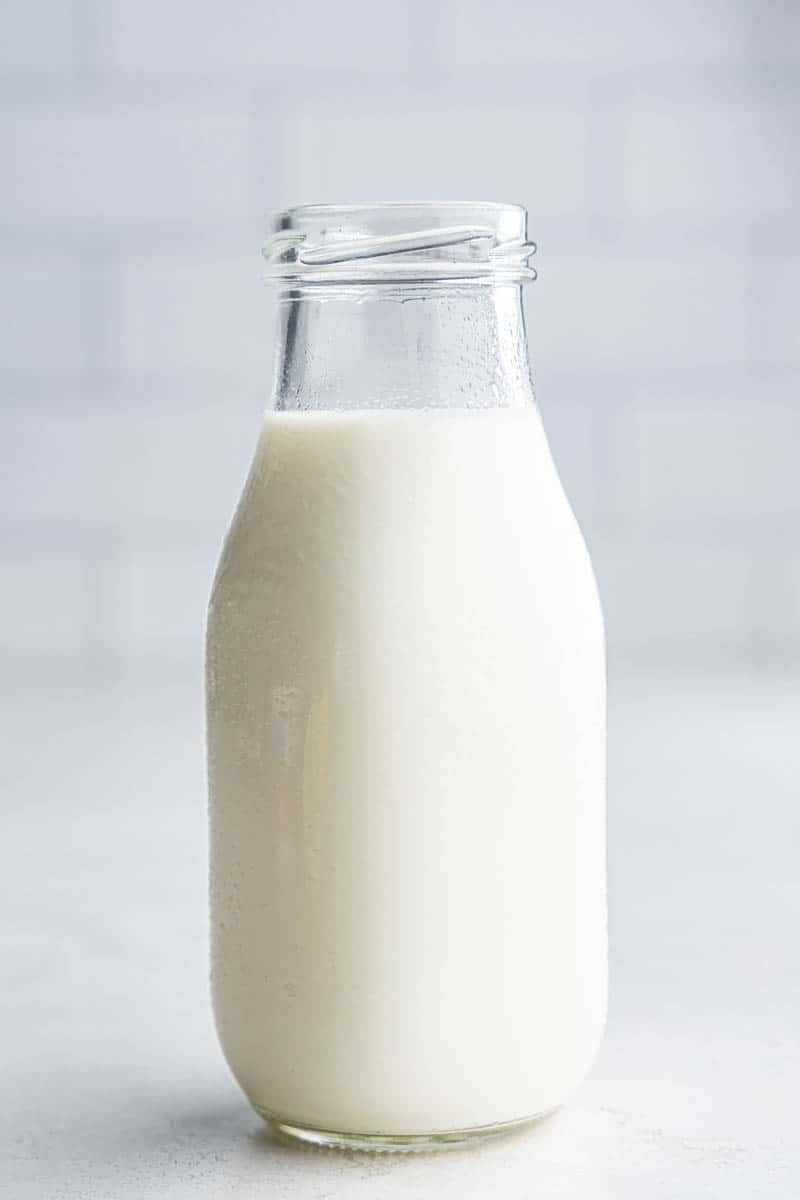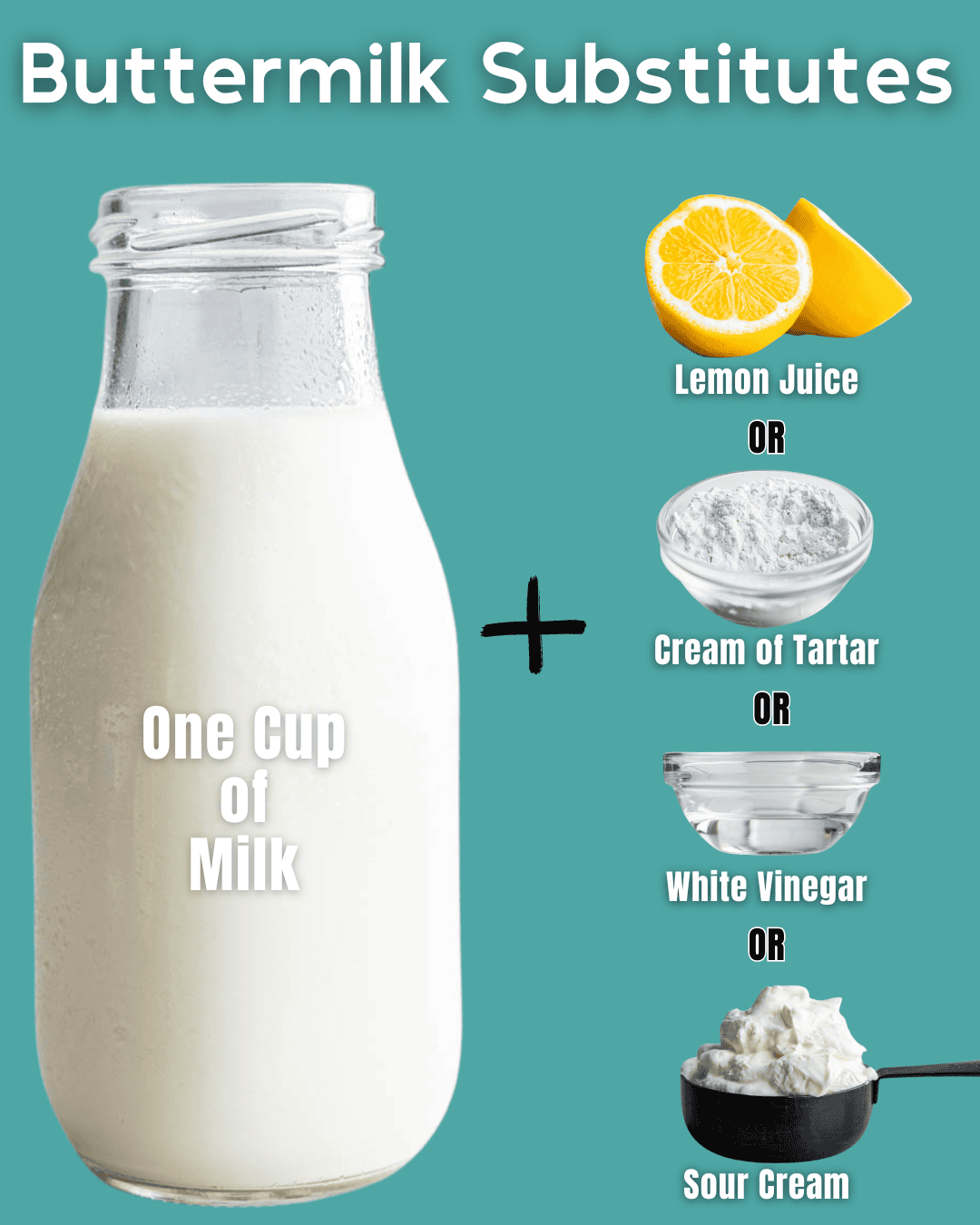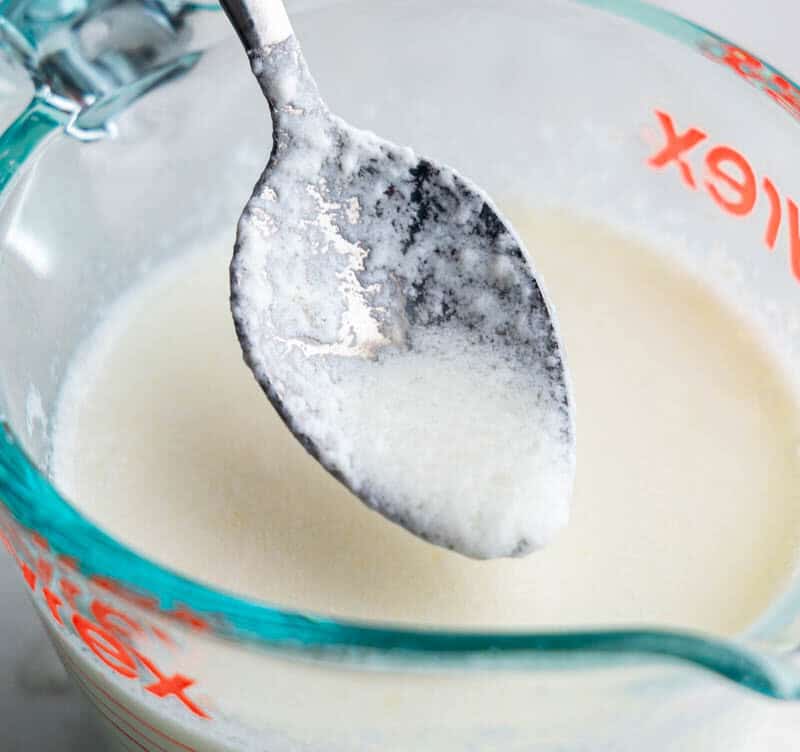Never run out of buttermilk again! Learn how to replicate the creamy, tangy qualities of buttermilk for your favorite recipes, without having to buy a whole carton or run to the store yet again. Whether you’re making fluffy pancakes, moist cakes, tender marinated meats, or even a homemade ranch dressing, these substitutes will come in handy if you find yourself without buttermilk. This guide offers simple solutions, including dairy-free options.
Why Our Guide
- Straightforward guide to quick substitutes plus when each one works best.
- Diary-free options for use with almond milk, oat milk, and other milk alternatives.
- Visual reference and printable guide to keep on hand in your kitchen.

What You Need to Know About Buttermilk
Traditionally, buttermilk is the liquid leftover after churning butter. What is sold in most grocery stores is cultured buttermilk, which is made by adding lactic acid bacteria to regular milk. Buttermilk has a sour taste and can be drunk straight or used in cooking and baking.
Buttermilk is usually sold in small cartons or bottles. Find it in the refrigerated section of your grocery store, near other milk products like sour cream and heavy cream.
Powdered buttermilk, or buttermilk powder, is a shelf-stable powder that makes liquid buttermilk when combined with water or milk. The general ratio used is 1 part buttermilk powder to 1 part liquid.
Can I just use milk instead?
Buttermilk reacts with rising agents, like baking soda and baking powder, to form carbon dioxide and act as a leavening agent. If you have a recipe that calls for both buttermilk and a rising agent, you shouldn’t substitute regular milk. Either purchase a carton or make your own substitution for buttermilk at home.
The 3 Main Buttermilk Substitutes
Each substitute listed can be easily prepared with common kitchen ingredients. Below, you’ll find the substitutes categorized by their best uses in cooking and baking:
1. Milk + Lemon Juice or Vinegar
- Best for: All-purpose use in breads, pastries, cakes, and other baked goods.
- Avoid in: Recipes that require a thicker consistency or richer texture like marinades or dressings.
- Instructions: Add 1 tablespoon of lemon juice or white vinegar to 1 cup of milk. Stir and let it sit for about 5 minutes until slightly thickened.
2. Milk + Cream of Tartar
- Best for: Recipes requiring a subtle tang and a fine crumb like muffins, cakes, quickbreads, or scones.
- Avoid in: Marinades or dishes where a stronger acidic profile is needed, as its effect is milder compared to vinegar or lemon juice.
- Instructions: Mix 1 3/4 teaspoons of cream of tartar with 1 cup of milk. Stir and let it sit until it starts to curdle.
3. Milk + Sour Cream or Plain Greek Yogurt
- Best for: Rich, dense baked goods and dishes where moisture and fat are beneficial. This substitute is excellent for chocolate cake, luxurious pancakes, and creamy dressings where a thick, rich texture is deal.
- Avoid in: Light, fluffy recipes where the heavy nature of sour cream or yogurt might weigh down the final product, such as angel food cake.
- Instructions: Combine 3/4 cup sour cream or yogurt with 1/4 cup milk. Whisk until smooth.

Dairy-Free Options
For those avoiding dairy, you can use the first three combinations with non-dairy milk like oat, soy, or almond milk. Oat and soy milk are preferred for their texture and flavor compatibility with traditional dairy milk. However, almond milk might result in a thinner consistency. Other varieties will also work in a pinch, but sometimes coconut milk and rice milk have a hard time curdling or thickening just right.
Storage Instructions
It’s so quick and easy to make homemade buttermilk substitutes, so we suggest mixing just what you need as you need it. If you happen to use this ingredient frequently, you can store larger batches.
Refrigeration: Mix only what you need but if necessary, store in the fridge for up to 1 week in a sealed jar or container. Shake well before use.
Freezing: Pour the substitute into a freezer-safe container, leaving some space at the top. For smaller portions, freeze in an ice cube tray and then transfer to a sealed container. The USDA says that buttermilk can be frozen for up to 3 months. Thaw in the refrigerator overnight when ready to use.



hi! some yeas ago i discovered your site. great discover!
since then i have made a few times the amazing chocolate cake which is so great that we( me and hubby) love it more then the sacher torte! im romanian bt i live in north Italy and here they have the tradition with this sacher torte. i tell you tha your cake was much more appreciated in my family then the other one! more delicious!
thank you so much for your effort for this site!
be blessed!
Maria Gaidau
The milk to be used to make the buttermilk, should be warm or hot while putting the white vinegar??
The milk should be cold.
Can i use cake flour for the chocolate cake?
We don’t recommend using cake flour in our chocolate cake recipe.
Dear Rachel, thank you so much for the recipe and the video. My 9 year old daughter (with some help) followed your recipe for her baby sister’s birthday cake and it turned out Amazing! The batter was more runny than your video so we just adjusted the cooking time. We were scared it out over cook but it was still so moist and tasted great. You really helped her make something special and memorable.
Hi Rachel, i have someone who”s allergic to milk products,what should i use instead of buttermilk?
You can use a non-dairy milk and add vinegar or lemon juice to it.
BUTTERMILK SUBSTITUTE WITH yogurt also
I’ve used apple cider vinegar in regular milk as a substitute before. The recipe I followed actually called specifically for that if actual buttermilk wasn’t an option. I was skeptical because it has such a strong smell and flavour but it actually worked very well. And you couldn’t taste it at all.
Thank you! Love your buttermilk trick! Solved my problems too.
1st time made this recipe cake came out amazing!! Making it for the second time, thank you for the wonderful recipe, this cake is deff the one from Matilda!!!
This is the best chocolate cake I have ever made that tastes likr heaven…Thank you Rachel